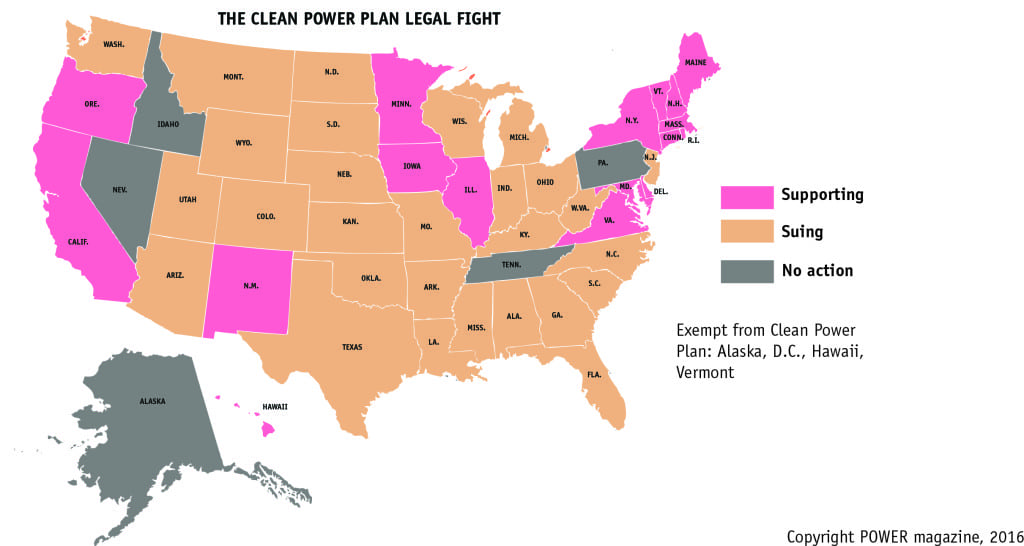Fight to Keep EPA’s Clean Power Plan Alive Intensifies in Federal Court
A coalition of 24 states and localities have urged a federal court reviewing the merits of the Environmental Protection Agency's (EPA's) Clean Power Plan to stall the agency's recent motion to suspend a case challenging the controversial rule.
West Virginia v. Environmental Protection Agency (No. 15-1363) is arguably the most important set of environmental cases in nearly a decade. For the U.S. power sector, the stakes are particularly high. The sector has grappled with uncertainty about the Clean Power Plan's future since the Supreme Court issued a stay of the rule on February 9, 2016.
The D.C. Circuit Court of Appeals heard oral arguments in the case before an en banc panel on merits of the EPA's controversial rule on September 27, 2016.
Twenty-seven states are challenging the legality of the rule finalized by the EPA under the Obama administration. They are: Alabama, Arizona, Arkansas, Colorado, Florida, Georgia, Indiana, Kansas, Kentucky, Louisiana, Michigan, Mississippi, Missouri, Montana, Nebraska, New Jersey, North Carolina, North Dakota, Ohio, Oklahoma, South Carolina, South Dakota, Texas, Utah, West Virginia, Wisconsin, and Wyoming.
Meanwhile, 17 states-California, Connecticut, Delaware, Hawaii, Illinois, Iowa, Maine, Maryland, Massachusetts, Minnesota, New Mexico, New York, Oregon, Rhode Island, Vermont, Virginia, and Washington-and the District of Columbia are supporting the Clean Power Plan in the merits litigation. A number of power companies are also participating as intervenors, including Calpine, Pacific Gas & Electric, NextEra, and Southern California Edison Co.
A Doomed Rule?
President Donald Trump, who vowed to decimate the rule on the campaign trail, on March 28 signed the "Promoting Energy Independence and Economic Growth" executive order, rescinding a substantial number of key provisions outlined by the previous administration's climate agenda and directing a review of some rules that may place costly burdens on coal generators, coal miners, and oil and gas producers. A key measure calls on the EPA to begin a reevaluation of the Clean Power Plan and the New Source Performance Standards.
Hours after Trump signed the executive order, the EPA announced it had initiated a review of the rule. Nearly as immediately, the Justice Department asked the D.C. Circuit to hold the consolidated cases in abeyance until the EPA can fully review the rule and respond to the president's executive order. Justice Department lawyers argued that "such abeyance will promote judicial economy by avoiding unnecessary adjudication and will support the integrity of the administrative process."
On March 31, EPA Administrator Scott Pruitt sent a "guidance" letter notifying state governors that they are not obligated to spend resources to comply with the Clean Power Plan while it is stayed by the Supreme Court.
States: Court Ruling Necessary, Not Just for Clean Power Plan
But on April 5, the 17 states, the District of Columbia, and other localities that support the EPA's rule filed a motion to hold the EPA's proceeding in abeyance. "EPA fails to justify its unprecedented request for an open-ended abeyance at this late stage of litigation: more than six months after the en banc Court heard a full day of oral argument," the motion argues.
"This case is ripe for decision now, and nothing that EPA has proposed to do obviates the need for this Court's review. To the contrary, a decision from this Court will resolve critical live disputes over the scope of the Clean Air Act that will not only determine the enforcement of the Clean Power Plan, but also affect any reconsideration or revision of the Rule that EPA may undertake."
The court's ruling is necessary to define boundaries and resolve legal issues that would "almost certainly arise" if the EPA acts to rescind or revise the rule, the coalition said. That includes the EPA's longstanding interpretation that it can regulate different pollutants from the same source under Section 111 (d) and Section 112 of the Clean Air Act. The court would also resolve the legal dispute of whether the EPA can consider generation shifting in determining the best system of emission reduction, and if generation shifting is limited to "inside-the-fenceline" measures, it added.
Indefinitely deferring a decision on the case would also waste substantial resources already expended on the litigation by all parties, including the court, the motion says. "Moreover, granting EPA's motion would prejudice State Intervenors' longstanding and compelling interest in addressing the largest sources of pollution that is causing climate-change harms now."
In a statement on April 5, New York Attorney General Eric Schneiderman said that the law was clear that the EPA is obligated to limit carbon pollution from power plants. "In order to repeal Obama-era protections, the Trump Administration must replace those protections, as well-and we know how well repeal-and-replace went the first time around."
Schneiderman noted that if the court grants abeyance of the case requested by the EPA, litigation on the rule would be stayed for years.
-Sonal Patel, associate editor (@POWERmagazine, @sonalcpatel)
The post Fight to Keep EPA's Clean Power Plan Alive Intensifies in Federal Court appeared first on POWER Magazine.
